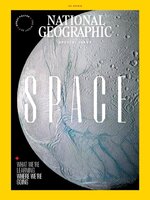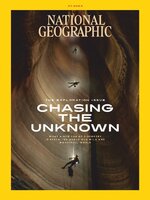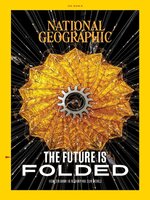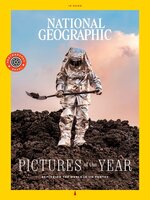What's inside the yellow box? Amazing discoveries and experiences await you in every issue of National Geographic magazine.
FROM THE EDITOR
CONTRIBUTORS
NATIONAL GEOGRAPHIC EXPLORERS • These contributors have received funding from the National Geographic Society, which is committed to illuminating and protecting the wonder of our world.
MAKING OF A MASTERPIECE • LOOKING AT THE EARTH FROM EVERY POSSIBLE ANGLE
THE BACKSTORY • A PHOTOGRAPHER CHRONICLES ‘SOMETHING SPECIAL’: THE COMPLEX EFFORT THAT BUILT A NEW SPACE OBSERVATORY.
Interview With a Rock Star Scientist • BRIAN MAY—CO-FOUNDER OF THE BAND QUEEN, CONSULTANT TO NASA—BLENDS ASTROPHYSICS AND ROCK MUSIC TO CREATE COSMIC HARMONY.
DESIGNING WOMAN • Sabrina Thompson is on a mission to empower women, starting with a flight suit that fits.
Farming produce, darkly
SOLAR POWER FROM SPACE • SCIENTISTS ARE HONING TOOLS THAT WOULD SEND THE SUN’S ENERGY TO EARTH AS RADIO SIGNALS.
Star creation, in miniature
A SOARING LIFE’S LEGACY • ARTIFACTS FROM SALLY RIDE’S CAREER AND PERSONAL LIFE BEAR WITNESS TO HER ROLE AS A PATHFINDER—IN SPACE AND BEYOND.
GAWKING AT ROCKETS • FROM COAST TO COAST, LIFTOFF FANS IN THE U.S. ARE MAKING PILGRIMAGES TO A HISTORIC NUMBER OF NEW ROCKET LAUNCHES.
ROCKET LAUNCH TOURISM
Welcome to the Cosmic Odyssey • WHEN TODAY’S EXPLORERS LOOK TO THE HEAVENS, THEY BECOME PART OF ‘A THRILLING, HUMBLING, AND THOROUGHLY ENTERTAINING JOURNEY OF DISCOVERY.’
When Innovation Is Extraterrestrial • THESE NATIONAL GEOGRAPHIC EXPLORERS ARE LOOKING INTO THE LIMITLESS FUTURE OF SPACE.
A NEW ERA OF DISCOVERY SPACE
UP + AWAY • NASA’S ARTEMIS PROGRAM BRINGS US ONE GIANT LEAP CLOSER TO THE MOON, MARS, AND BEYOND.
BACK TO THE MOON
GOING THE DISTANCE
INTO THE SHADOWS
FOCUS • Machine learning is helping us bring mysterious black holes into sharper view.
TIME TRAVEL TO ANCIENT GALAXIES • THE MOST POWERFUL SPACE TELESCOPE EVER BUILT IS HUNTING FOR THE ORIGINS OF THE UNIVERSE.
DECODING THE DAWN • The universe’s hazy infancy, known as the dark ages, ended with the arrival of the first stars. Their light launched a process that broke up and cleared the cosmic fog, fueling a billion-year transformation of the universe into a host of galaxies, black holes, and other phenomena across our night sky.
LIGHT • Vying for room at the edge of space, growing satellite traffic is crowding the skies.
THE ALIEN MOON SHOT • ASTROBIOLOGISTS ARE SEARCHING THE SOLAR SYSTEM’S ICY MOONS FOR LIFE. BUT FIRST, THEY MUST TEST THEIR TECHNIQUES HERE ON EARTH.
OCEANS BEYOND EARTH • Liquid water—warmed indirectly by gravitational forces—exists on several of the solar system’s moons. Some may even contain exponentially more water than exists on Earth. While liquid water is suspected on one of Neptune’s moons, the moons of Jupiter and Saturn are closer and easier to visit. Spacecraft are slated to explore their watery worlds over the next two decades.
EUROPA • Scientists suspect that hiding beneath Europa’s frozen surface is a saltwater ocean with twice the volume of all Earth’s oceans combined. Flying as close as 16 miles above the moon’s surface, NASA’s Europa Clipper spacecraft, scheduled to launch in late 2024, will use ice-penetrating radar and other sensors to seek out signs of liquid water within Europa’s ice shell and study organic molecules on its surface.
ENCELADUS • Scientific observations strongly suggest that Titan, Europa, and other moons in the solar system have liquid water beneath their surfaces. Saturn’s moon Enceladus, however, showcases its ocean by spraying so much salty water into space that it forms the planet’s diffuse, massive, and beautiful E...

 May 01 2024
May 01 2024
 Apr 01 2024
Apr 01 2024
 Mar 01 2024
Mar 01 2024
 Feb 01 2024
Feb 01 2024
 Jan 01 2024
Jan 01 2024
 Dec 01 2023
Dec 01 2023
 Nov 01 2023
Nov 01 2023
 Oct 01 2023
Oct 01 2023
 Sep 01 2023
Sep 01 2023
 Aug 01 2023
Aug 01 2023
 Jul 01 2023
Jul 01 2023
 Jun 01 2023
Jun 01 2023
 May 01 2023
May 01 2023
 Apr 01 2023
Apr 01 2023
 Mar 01 2023
Mar 01 2023
 Feb 01 2023
Feb 01 2023
 Jan 01 2023
Jan 01 2023
 Dec 01 2022
Dec 01 2022
 Nov 01 2022
Nov 01 2022
 Oct 01 2022
Oct 01 2022
 Sep 01 2022
Sep 01 2022
 Aug 01 2022
Aug 01 2022
 Jul 01 2022
Jul 01 2022
 Jun 01 2022
Jun 01 2022
